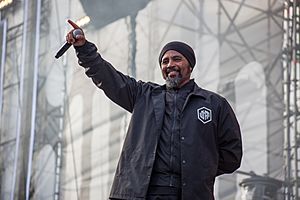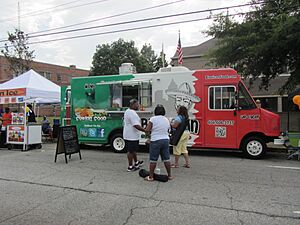Blaxican facts for kids

Artist Kemo The Blaxican (2019)
|
|
| Total population | |
|---|---|
| ~42,000 (Los Angeles County) | |
| Regions with significant populations | |
| California, Texas, Arizona, New Mexico, Georgia, Nevada | |
| Languages | |
| American English, African-American Vernacular English, Spanish | |
| Related ethnic groups | |
| African Americans, Mexican Americans, Afro-Mexicans |
Blaxicans are people who have both Black and Mexican American backgrounds. Some Blaxicans might prefer to call themselves Afro-Chicano or Black Chicana/o. They often connect with Chicano identity, culture, and political ideas. Most Blaxicans come from working-class neighborhoods where African Americans and Mexican Americans lived and interacted. Los Angeles is known as a main center for Blaxican culture. In 2010, about 42,000 people in Los Angeles County identified as both Black and Latino. Most of these people are believed to be both Black and Mexican American.
Many Blaxicans face challenges because of how race is seen in the United States. Sometimes, people try to define them as only one race. They can also face unfair treatment within Mexican American communities and sometimes feel unwelcome in Black American communities. People often question if they are "truly" Black or "truly" Mexican. Experts describe Blaxicans as "dual minorities." This is because their families come from two groups that have historically faced social, political, and economic difficulties.
Contents
A Look at Blaxican History
Even though Blaxican experiences are only recently getting more attention, their history goes back a long way. Scholars say that Black Mexican Americans were present when Pueblo de Los Ángeles was founded in 1781. Records show that 26 of the 44 Mexicans who started the city were of African descent.
In the 1960s and 1970s, Black and Chicano communities worked closely together. They joined forces during important civil rights struggles. They also cooperated in union activism and as neighborhoods changed. However, there were also times of tension between Black and Chicano groups. This sometimes happened because of competition for limited resources.
Experts have noted that there have been historical difficulties between Mexican American and African American communities. These challenges have made things harder for people who are part of both groups. Blaxican scholar Walter Thompson-Hernandez points out that both Black and Mexican people have faced many hardships in U.S. history. He also notes that prejudice against Black people within Mexican American communities has caused division.
In the 1980s and 1990s, more Mexican immigrants moved into Black neighborhoods in South Los Angeles. This led to an increase in the Blaxican population in the area.
Understanding Blaxican Identity
Scholar Rebecca Romo explains that Blaxican identity means being okay with different ideas and cultures at the same time. It's like juggling two cultures. Blaxicans living on the East Coast of the United States are sometimes thought to be Puerto Rican, Cuban, or Dominican. This is because there are fewer Mexican Americans in that region compared to other Latino groups.
Being Seen as "Authentic"
Blaxicans are often judged as not truly Mexican if they look mixed or only Black. This can happen if they do not speak Spanish. In Mexico, the idea of mestizaje is common, which suggests that most Mexican people are of mixed Indigenous and European heritage. This idea can lead to assumptions. Also, during the Chicano Movement, there was a focus on a distinct Brown race. This has sometimes led people to assume that if someone looks Black, they cannot also know about Mexican American culture.
Similarly, Blaxicans are often judged as not truly Black. Scholar Rebecca Romo notes that for African Americans, being seen as "authentic" can be very important. This is because Black people have historically faced many challenges. Some things Blaxicans mention as signs of being "authentic" Black include how they dress, talk, their connection to hip-hop culture, and knowledge of African American history. Other signs can include certain hair types, darker skin, and being from a working-class background.
Blaxican Culture
Blaxican culture is a mix of elements from African American and Mexican American cultures. Photographer Walter Thompson-Hernandez has a project called "Blaxicans of L.A." that shows the Blaxican experience. Poets like Ariana Brown and Natasha Carrizosa are Blaxican. Musician and painter Ras Levy is also a notable Blaxican artist.
Recording artists include Miguel, Kemo The Blaxican from Delinquent Habits, and Afro-Chicano rapper Choosey. Kemo The Blaxican says that Black and Latino hip hop artists have always worked together since the early days of hip-hop. Choosey explains, "there’s a stigma that Black and Mexican cultures don’t get along, but I wanted to show the beauty in being a product of both.”
The Blaxican is a popular food truck owned by Will Turner in Atlanta, Georgia. It serves "Mexican Soul Food" and has been in business for over ten years. A restaurant location opened in 2016 but closed in 2020 due to economic pressure from the coronavirus outbreak. The food truck was saved thanks to a campaign by Alexis Akarolo and Ze Clark. They started a fund to help Black-owned businesses during the pandemic.


